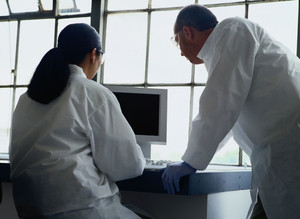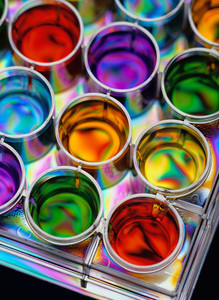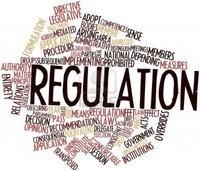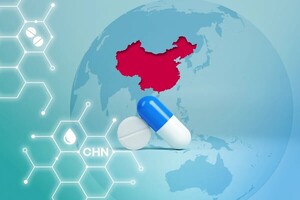Biotechnologically produced drugs, so called biologicals, are a major growth driver for the global pharmaceutical market. In 2007 the biologicals market grew noticeably faster than the overall market; with a double-digit growth of 20%; they generated US$95 billion (Euros 64.93 billion) of sales amounting to approximately 15% of global pharmaceutical revenues.
This bright outlook for biologicals is likely to continue. Accenture research shows that the pipelines of the pharmaceutical industry are filled with more than 500 biologicals in various stages of development and that their proportion among the number of newly approved drugs is constantly growing.
By 2010, approximately one-third of all newly approved drugs will be biologicals. In-line with this development, the market for generic versions of biologicals is becoming more and more interesting as the patents of first-generation products like erythropoietin (EPO), granulocyte colony stimulating factor (G-CSF), human growth hormone (hGH), insulin and interferon are expiring.
This patent expiration offers companies the opportunity to enter a new, attractive market with the production of replicas of biologicals—so-called biosimilars. Today, total sales of off-patent biologicals amount to approximately US$20 billion (Euros 13.67 billion), and this will considerably increase over the next few years. Sales volumes of biosimilars for these drugs are still low, but are expected to grow very rapidly with the entry of more products and new players.
While the challenges are greater than for classic generics, success may come down to safety, efficacy and convenience of the drugs rather than price, it says.
The challenge for the development of biosimilars arises from the fact that biologicals are more complex than small-molecule and chemically synthesised drugs; therefore their replicas are—in contrast to ‘traditional’ small-molecule generics—‘similar’ but not identical to the original drug. The EMEA and FDA have recognised this fact and established the official terms ‘biosimilars’ (EMEA) and ‘follow-on biologics’ (FDA).
The characteristics of biologicals are in large part determined by their manufacturing process. Minor differences in cloning, fermentation or purification can lead to variations of tertiary and quaternary structures and post-translational modification patterns of proteins.
These variations can significantly modify the activity, stability, specificity and immunogenicity, which can thus differ significantly from the originator product. Consequently, the registration of biosimilars requires more data than for generics, and manufacturers have to demonstrate efficacy and safety in pre-clinical and clinical studies. This makes the registration of biosimilars a costly and time-consuming process.
The regulatory frameworks for biosimilars in Europe and the United States are in different stages. A robust legislative framework enabled the EMEA to develop a series of guidelines for biosimilar approval, and in 2006 the first biosimilars were authorised. Since then, additional approvals have occurred. These products are all based on protein classes that were originally launched in the early to mid-1980s and with recent patent expiries.
The situation in the United States is more complicated: biologicals are controlled under the Public Health Service Act, which does not contain an abbreviated pathway as for ‘normal’ generics. Therefore, the FDA expressed a demand for new legislation to handle biosimilar/follow-on biologics. A final decision can be expected under the Obama administration and the first biosimilars will likely enter the US market before the end of 2009.
Trends
Analysing the current situation, Accenture has identified several trends for how the market for biosimilars will likely develop. In general, for biosimilars with higher barriers-to-entry compared to ‘classic’ generics, competition will be less intensive, leading to a comparably lower margin pressure and a more interesting profitability structure. Key differentiators will be technologies and capabilities and—to a lesser extent—low prices and market share. The trends are:
Increase in biosimilar approvals and market growth both in Europe and the US: The EMEA expects further approval applications in 2009 and the coming years; also, in the United States, with new legislation in place, the first biosimilars will likely enter the market. In 2010 the biosimilars market is expected to grow to approximately US$5 billion (Euros 3.41 billion). Further patent expiries of biologicals will likely increase the number of approved biosimilars and players in the market.
Cost saving potentials by biosimilars: The prices of a biosimilar are approximately 20–30% below the original product price. An increase in market competition might lead to further reductions, but due to high necessary upfront investments, biosimilars are unlikely to realise the price reductions of 70–80% typical of ‘classic’ generics. Nevertheless, payers and healthcare systems can still achieve significant savings since biological treatment costs are on average US$50 (Euros 34.18) per day, some 20 times higher than traditional pharmaceuticals. Therefore, this price reduction could also allow a higher number of patients to benefit from innovative and expensive treatments.
Higher margins and interesting profitability structure: The regulatory authorities have emphasised that biosimilars need to be treated differently from generics as they can establish only a similarity to their reference product. Therefore, an automatic substitution in the pharmacy, as seen for classic generics, is currently not intended and unlikely to be implemented. Thus, even if several biosimilars, referencing the same originator drug, compete with each other, an intensified price pressure with rebate contracts and other discounts is less likely to take place than with classic generics. This will make biosimilars a comparably more profitable and higher margin business than generics, with less price regulation and pressure by payers and governmental bodies.
Careful selection of protein classes: For the short-term, manufacturers of biosimilars will focus on the five protein classes of EPO, hGH, G-CSF, insulin and interferon due to their recent patent expiry. In the long term, more complex proteins will likely also be ‘biosimilarised’. But it can still be expected that individual companies will focus their production and marketing on selected protein classes driven by strategic fit and operational feasibility.
Uncertainties and risks for biosimilars manufacturers: Uncertainties and risks for biosimilars manufacturers will continue to be relatively high. The regulatory frameworks in Europe and the United States are becoming more robust, but the guidelines still will not allow a standardised approval process, forcing both agencies to continue with case-to-case decisions. Furthermore, reluctance from physicians and patients to prescribe and use biosimilars due to potential efficacy and safety issues might hurt prescription behaviour, making the early adoption of biosimilars difficult. Thus, the probability of a successful product launch is lower compared to the generic market.
According to Accenture, biosimilars will evolve to an interesting market in the coming years and with its very specific dynamics, this market will differ significantly from those for originator products and for classic generics. In general, biosimilars will be a higher-risk but also higher-rewarded business than compared to classic generic drugs.
The dynamic developments will put pressure both on originator companies and generics firms to meet these challenges and to develop a position in this new environment. Based on the analysed trends, Accenture sees the following likely strategic options:
Option 1: Generics firms successfully enter into the biosimilars market
Without the necessity of undertaking costly full-scale R & D activities, generic firms can master the manufacturing and marketing of recombinant proteins. Scrip News mentions Teva Pharmaceutical Industries as an example.
In the long run it is possible they will gain the expertise and resources needed to modify and improve biopharmaceuticals and bring innovative biologicals to the market, as the core competencies for production, development and approval needed for both biologicals and biosimilars are largely the same. However, success in the biosimilars industry will require significant capital investment and in-house experience. In particular, biosimilars manufacturers have to face higher costs for manufacturing, clinical development, registration and product marketing compared to classic generics. Therefore, market entry barriers are especially high for smaller generics firms, as these obligations require a significant upfront as well as long-term investment. Intense competition and financial pressure in the generics market might make it difficult for these players to deal with the financial risk and to afford the required investments.
Option 2: Pharmaceutical companies expand their biologicals business and enter biosimilars market opportunistically
Pharma companies could develop strategies to complement and expand their therapeutic portfolios by bringing biosimilars of other companies to the market, since they have the required R & D, manufacturing, regulatory and marketing competences and experiences in-house. This would allow them to expand portfolios faster, with less R & D risk and cost, establishing additional sources of revenue. Scrip News mentions Merck & Co establishing Merck Bioventures as an example.
For selected pharma companies with both pharmaceutical and generics expertise in-house, there is also the possibility for a company to make an internal ‘switch’, i.e., launching a biosimilar of the company’s own biological product. This option might only be taken into account for older first-generation biologicals, whose second-generation biologicals are about to be launched. This could be an interesting opportunity for those corporations pursuing both an original product and generics strategy.
Option 3: New types of cooperation between pharma, biotech or generics
As a third option, new forms of cooperation between relevant players—pharma, biotech or generics—could evolve. Another likely scenario is the cooperation and stronger alignment between pharma companies and generic firms. Scrip News mentions Teva's joint venture with Lonza as an example.
Key factors to success
The development of the biosimilar market will bring a new dynamic into the pharma world. Despite the described risks and challenges, it will open up very interesting opportunities for both pharma and generic companies.
The dynamics in the biosimilar market will be more challenging than in the classic generic market requiring greater investments and risks, forcing the producers to make careful selection of protein classes, building up new competencies and developing new models for cooperation.
In general, the main differentiator for players in the biosimilars market will be safety, efficacy and convenience of their products; and to a lesser extent the price of their drugs.
To achieve high performance in such a complex and dynamic market, biosimilars manufacturers need to consider the following key success factors:
- The decision to enter the market should only be made based on a clearly defined long-term biosimilar strategy that addresses important long-term considerations, development and manufacturing capability investments, marketing, pricing and commercial approaches as well as geographic and regional focus.
- Entrants need to have a healthy financial structure to perform high upfront investments. They also need to carefully assess if and how they can make the required investments into facilities and capabilities to successfully bring a biosimilar onto the market, taking into account regulatory risks and reluctance from physicians and patients to adopt biosimilars when projecting future sales.
- Manufacturers of biosimilars will need to build up comprehensive competitive intelligence on the biologicals and biosimilars market and pipeline and R & D activities of competitors to successfully select target biosimilars with optimal sales potential. As their products will not only compete with originator brands but also other biosimilars entrants, second-generation branded biologicals, second-generation biosimilars and other branded biologicals, they need to understand the pipelines of relevant competitors and how they will likely act in the near future, to be able to make strategic and tactical decisions of which biosimilars to select and develop.
- Established core competencies for a stable, reproducible manufacturing process are the basis for successfully gaining access to the biosimilars market. Key production processes need to be built up (either in-house or in cooperation with an experienced partner) and fully established to lead to the desired outcome. Proper supply chain management and further optimisations might result in improved products and thereby better position them on the market.
- Biosimilar producers have to build up deep clinical development expertise including pharmacovigilance and regulatory capabilities; and appropriate balance between in-house and outsourcing to clinical research organisations. Organisation and processes need to be clearly defined and established to allow fast generation of high-quality data and proper management and analysis of a large amount of information. This will support the fast development of a product, minimising costs and failure risks. In addition, development capabilities need to be tightly integrated with production facilities, which represent a major challenge to create biosimilars that are comparable to the original biologicals.
- To commercialise biosimilars, companies need to have customised marketing and sales activities for the medical community and beyond. This can include scientific communication activities with regulatory agencies, opinion leaders and physicians as well as the sales force detailing activities for medical discussions with doctors and to promote product uptake. For a successful commercialisation, targeted geographies need to be carefully selected and commercialisation approaches tailored to the market environment.
References:
Scrip News 9 September 2009. Accenture report outlines key to success in the biosimilars market.
Accenture 2009 report. Biosimilars: emergence of a third market dynamic between original products and generics.
Source: Scrip News; Accenture 2009 report








 0
0











Post your comment